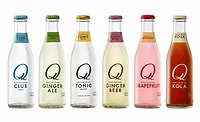Craft spirits market poised to boom
With younger drinkers increasingly making cocktails their drink of choice, now might be the time to look to craft liquor.

Millennials, once again, are rapidly changing alcohol beverage trends, now exhibiting a preference for craft liquor produced by small, local distilleries, such as Whistle Pig, a Vermont distillery that grows some of the rye used in its whiskey.
The industry is set to see significant acceleration in the near future, but spirits industry leaders seeking to grow will need to make some appropriate acquisitions. The question is which ones?
In the following Q&A, Akshat Dubey and Rakesh Mani, leading practitioner on the US deals strategy team in the retail and consumer sector at Strategy&, PwC’s strategy consulting business, offer insights for established companies facing the rapidly-changing spirits sector:
FE: How fast is the craft liquor industry expected to grow and how large is it estimated to be? Why is this industry expected to boom?
Dubey/Mani: The US craft spirits industry is poised for dramatic growth. In 2016, craft distillers sold 4.9 million nine-liter cases. By 2020, volumes are expected to grow to 25.6 million cases — an annual growth rate of about 40 percent.
About 1,300 distillers collectively hold down ~2.2 percent volume share of the overall spirits market today (up from 0.8 percent just five years ago). By comparison, craft beer holds about 13 percent of the overall beer market. If craft spirits were to behave like craft beer, we could see craft spirits gaining an additional 10 percentage points of volume share in the coming years.
The boom is being driven by a few factors:
1) Spirits as a whole have been gaining greater “share of throat” among American consumers, with most of this coming at the expense of beer.
2) A growing share of younger drinkers are willing to pay a premium for fresh brands that are imbued with originality and a unique identity.
3) Distillers have been making significant investments in production capacity as well as marketing — through tasting rooms and millennial-focused messaging.
4) Perhaps most importantly, as Millennials and Gen Z’s grow in scale as a consumer group, they are implanting their distinct brand preferences (e.g., sustainable, experiential, personalized) that are “cool” to this generation. In many industries, that has implied a jettisoning of “old world” brands that were revered by their parents. We’re seeing that happen already in food, apparel, confectionery and other consumer durables such as razors. Spirits — and more broadly, alcohol — is no exception to this trend.
FE: What kind of products will this industry be expected to produce? Why do millennials prefer these products as opposed to other alcohol, such as wine or beer?
Dubey/Mani: The resurgence of “cocktail culture” and a penchant for more mature, sophisticated beverage consumption has helped buoy spirits volumes in the last several years. Spirits’ “share of throat” is expected to rise to about 35 percent of all alcohol volumes in the U.S. (from just 29 percent in 2010). Much of this growth comes at the expense of beer, which is often perceived as less suave, and more unhealthy.
Several categories have been rich beneficiaries of this American spirits renaissance, with a raft of new labels across both brown and clear spirits. That said, some categories have led most of this growth (e.g., bourbon, tequila, gin) while others have been slower to build traction (e.g., rum)
In fact, 35 percent of all craft spirits labels are whiskies (tailed by gin and vodka, at 15 and 12 percent respectively), which have been helped in no small measure by popular television shows (such as Mad Men) which have framed the zeitgeist. While we expect that bourbon and whisky will continue to see elevated interest, we also expect more innovation and growth in categories such as rum and mezcal.
FE: What type of companies should be looking at acquiring smaller craft liquor companies?
Dubey/Mani: Large beverage alcohol players have been active in pursuing deals in the space — whether in making outright acquisitions, or in taking minority positions. In some cases, the focus has been on filling portfolio gaps by acquiring brands with the “craft halo” to build credibility with consumers. In other instances, players that have traditionally focused on beer and wine have also been evaluating options to tap into the zeitgeist and extend into the spirits space, through adding some craft labels to their portfolio.
However, the larger craft distilleries would fancy themselves as potential suitors as well — the top 2 percent of craft distillers account for 50 to 60 percent of all craft spirits volume. These larger craft players could extend their product portfolios, production capacity, or geographic reach by buying smaller distilleries.
FE: What are some of the characteristics of smaller companies that might make them more attractive to acquire?
At the surface level, acquirers have focused on distilleries that have a rich heritage and identity which can translate into effective marketing cues around originality and authenticity which is differentiated from the “big” and “old” spirits brands that are more familiar names.
For craft distillers, this implies a few things:
1. A quality product: this is the most important factor in determining the long-term success of a craft brand. Distillers need strong brand cachet, which is built by perceptions of the everyday consumer and is supported by critics’ awards at industry competitions.
2. Strong marketing capabilities: essentially, effective grassroots marketing (which isn’t always the forte of larger players). Some have successfully converted bartenders into ambassadors. Others have tapped into the interests of their demographic (e.g., with digital ad campaigns) or built unique tasting experiences at their distilleries (where ~ 25 percent of sales still occur).
3. A diversified portfolio: having a mix of product categories — of brown and clear spirits — prevents supply constraints and opens doors for further growth. It also allows distillers to cater to a wider range of consumer occasions and taste profiles (e.g., sipping drinks vs. high-end cocktails).
4. Enhanced production: the amount of capacity available to a craft distiller defines their near-term growth potential and has an outsized bearing on valuations. The extent of unused capacity will determine the degree to which acquiring a craft distillery will move the needle for a larger player.
FE: Once they are acquired, how should a bigger company help grow the acquired company?
The primary consideration for larger acquirers should be to maintain the credibility of the original craft brand. Many buyers let a craft player run independently after an acquisition, and simply provide some distribution benefits and capital for brand support. This typically also means that the craft distiller’s founder or CEO remains on board, and that the acquirer minimizes intervention in day-to-day operations.
However, a large acquirer can also selectively provide other capabilities — especially in areas where scale offers significant benefits, such as ensuring the stability of raw material supply, driving down the price of ingredients and providing access to relationships with marketing agencies and its distributor network.
Successfully acquiring and growing craft distilleries requires tailored strategies, and a unique set of organizational capabilities. Large acquirers will need to thoughtful, and proactive, in identifying viable opportunities, while developing a clear-eyed focus on extending the growth trajectory of their acquisitions.
Looking for a reprint of this article?
From high-res PDFs to custom plaques, order your copy today!






